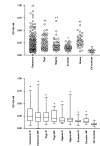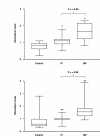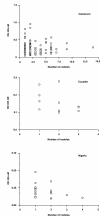Human immune responses to infective stage larval-specific chitinase of filarial parasite, Onchocerca volvulus, Ov-CHI-1
- PMID: 12685941
- PMCID: PMC153484
- DOI: 10.1186/1475-2883-2-6
Human immune responses to infective stage larval-specific chitinase of filarial parasite, Onchocerca volvulus, Ov-CHI-1
Abstract
BACKGROUND: Ov-CHI-1 is a chitinase specifically expressed in the infective stage larvae of the human filarial parasite Onchocerca volvulus. Evidence has show that it could be a vaccine candidate, however, there is no data available regarding the immunological status of people naturally exposed to infective stage larvae and thus provoked by this antigen. METHOD: We analysed the Ov-CHI-1-specific immune response present in four endemic foci of human onchocerciasis (Ecuador, Nigeria, Togo and Cameroon) by enzyme-linked immunosorbent assays and T-cell proliferation assays. RESULTS: In these foci of infection, antibodies to Ov-CHI-1 were found to be present in only 22% of individuals from Ecuador, but were detected in 42-62% of infected individuals in the three foci from West Africa (Nigeria, Togo and Cameroon). There was found to be no relationship between antibody level and age, gender, or infection intensity as indicated by microfilarial density and numbers of skin nodules. The isotype response to Ov-CHI-1 was dominated by the presence of IgG3, IgG1 was present to a lesser extent. Our results show a positive correlation between N- and C-termini of Ov-CHI-1 in their ability to provoke humoral and cellular immune responses in the human. Peripheral blood mononuclear cell (PBMC) proliferative responses to Ov-CHI-1 when assayed, were found to be significantly higher in the individuals from endemic areas and there was a statistically elevated response to Ov-CHI-1 in the infected individuals when compared to putative immune individuals. CONCLUSION: Ov-CHI-1 is an antigen that we have found strongly induces both humoral and cellular immune responses in humans.
Figures









References
-
- World Health Organisation Onchocerciasis (River Blindness): Fact Sheet No. 95, revised at February. 2000. http://www.who.int/inf-fs/en/fact095.html
-
- Philipp M, Davis TB, Storey N, Carlow CK. Immunity in filariasis: perspectives for vaccine development. Annu Rev Microbiol. 1988;42:685–716. - PubMed
-
- Ward DJ, Nutman TB, Zea-Flores G, et al. Onchocerciasis and immunity in humans: enhanced T cell responsiveness to parasite antigen in putatively immune individuals. J Infect Dis. 1988;157:536–543. - PubMed
-
- Nelson G. Order Filariata: Filarial worms in Onchocerciasis. Advances in Parasitology. 1970;8:488–491. - PubMed
Grants and funding
LinkOut - more resources
Full Text Sources

